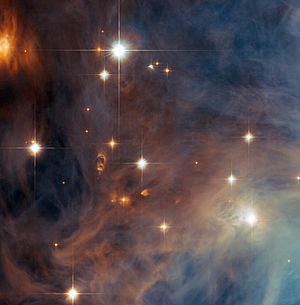M43 facts for kids
M43 is a bright cloud of gas and dust in space. It is found in the constellation of Orion, the Hunter. M43 is about 1,600 light-years away from Earth. It is actually a smaller, distinct part of the much larger and more famous Orion Nebula (also known as M42). This cosmic cloud is a place where new stars are being born.
Contents
M43: A Star-Forming Cloud
M43 is a type of space cloud called an HII region. An HII region is a giant cloud of ionized hydrogen gas. This gas glows brightly because it is lit up by very hot, young stars nearby. These stars give off a lot of ultraviolet light. This light strips electrons from hydrogen atoms, making them glow.
What is M43?
M43 is often called De Mairan's Nebula. It is a smaller, rounder cloud that sits just north of the main Orion Nebula. Even though it is smaller, M43 is still very bright. It is easy to see with a small telescope. It looks like a glowing patch of light.
Where is M43 Located?
You can find M43 in the sword of Orion. The Orion constellation is one of the easiest to spot in the night sky. It is visible from most parts of the world. M43 is very close to the famous Orion Nebula. The two nebulae are separated by a dark lane of dust. This dust makes them look like two different objects.
Discovering M43
M43 was first seen by a French astronomer named Jean-Jacques Dortous de Mairan. He discovered it in 1731. This was before the more famous astronomer Charles Messier cataloged it. Messier added it to his list of fuzzy objects in 1769. This is why it is known as M43, the 43rd object in Messier's catalog.
The Bright Star of M43
At the heart of M43 is a single bright star. This star is called NU Orionis. It is a very hot and massive young star. NU Orionis is responsible for making M43 glow. Its powerful ultraviolet light excites the gas in the nebula. This makes the gas emit its own light, which we can see.
Why is M43 Important?
Astronomers study M43 for several reasons. It is a great example of a star-forming region. By studying M43, scientists can learn more about how stars are born. They can also learn about how young, massive stars affect their surroundings. The glowing gas and dust provide clues about the early stages of star life. M43 helps us understand the universe better.


